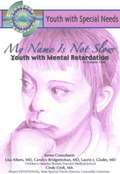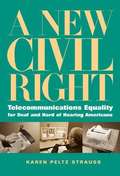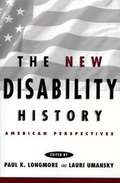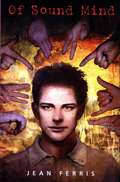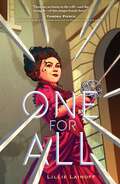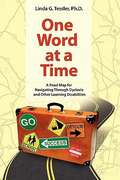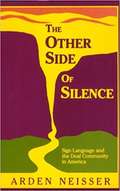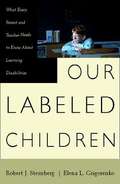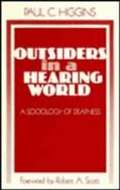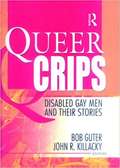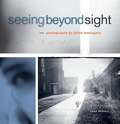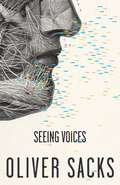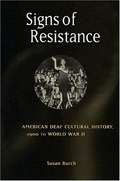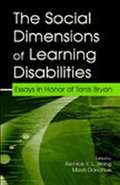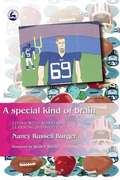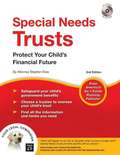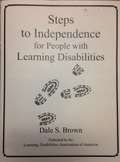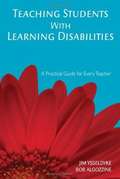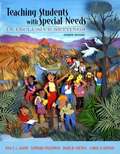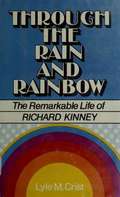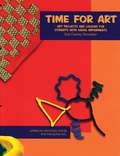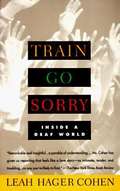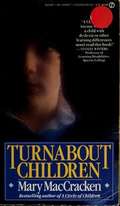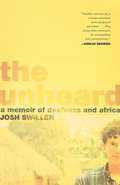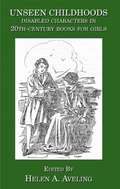Special Collections
Disability Collection
Description: Bookshare is pleased to offer a collection focused on the topic of disability and accessibility. #disability
- Table View
- List View
My Name is Not Slow
by Autumn LibalFrom the Book Jacket: When Mr. Brown peers through the glass window at his new daughter, she looks impossibly frail in the incubator. The doctors said shehas Down syndrome; she will have mental retardation. But what will that mean for Mr. Brown's daughter? What will she be able to do? Will she ever have talents like his other children? Will she feel joy from her accomplishments-or only pain from her limitations? Mental retardation is one of the most stigmatized disabilities in our society. People living with mental retardation are often treated as if they are simple, emotionless, child-like, or even less than human. And yet, individuals living with mental retardation have hopes and dreams, likes and dislikes, and talents and weaknesses just like anybody else. This book will help you learn about mental retardation, the special needs of individuals living with this form of disability, and the support systems available to help people with mental retardation acquire independence and success. As you read, you will meet Penelope Brown, one girl living with Down syndrome. Follow her story as she struggles both with her medical condition and with the ignorance of others. As you read, you will learn how Penelope and her family experience hope, disappointment, love, loss, and happiness as they learn what it means to live with mental retardation.
A New Civil Right
by Karen Peltz StraussKaren Peltz Strauss reveals how the paternalism of the hearing-oriented telecommunications industries slowed support for accessible technology for the deaf and hard of hearing users.
The New Disability History
by Paul K. Longmore and Lauri UmanskyIn a series of scholarly but highly readable essays, this book opens discussion on the role of disabled people in American history. It also examines how history has been affected by perceptions of disability. For example, one article looks at the ways disability has been used to strengthen prejudice against particular ethnic groups and to justify discrimination - "experts" have often claimed that one or another group of immigrants is genetically inferior and prone to mental retardation or physical frailty. One essay is based on the Civil War letters of a deaf man to his family. Another looks at the ways Helen Keller's Socialist beliefs were stifled by those around her.
Of Sound Mind
by Jean FerrisTired of interpreting for his deaf family and resentful of their reliance on him, high school senior Theo finds support and understanding from Ivy, a new student who also has a deaf parent.
One for All
by Lillie Lainoff“There are no limits to the will—and the strength—of this unique female hero.” —Tamora Pierce, writer of the Song of the Lioness and the Protector of the Small quartetsOne for All is a gender-bent retelling of The Three Musketeers, in which a girl with a chronic illness trains as a Musketeer and uncovers secrets, sisterhood, and self-love.Tania de Batz is most herself with a sword in her hand. Everyone thinks her near-constant dizziness makes her weak, nothing but “a sick girl.” But Tania wants to be strong, independent, a fencer like her father—a former Musketeer and her greatest champion. Then Papa is brutally, mysteriously murdered. His dying wish? For Tania to attend finishing school. But L’Académie des Mariées, Tania realizes, is no finishing school. It’s a secret training ground for new Musketeers: women who are socialites on the surface, but strap daggers under their skirts, seduce men into giving up dangerous secrets, and protect France from downfall. And they don’t shy away from a sword fight.With her newfound sisters at her side, Tania feels that she has a purpose, that she belongs. But then she meets Étienne, her target in uncovering a potential assassination plot. He’s kind, charming—and might have information about what really happened to her father. Torn between duty and dizzying emotion, Tania will have to decide where her loyalties lie…or risk losing everything she’s ever wanted.Lillie Lainoff's debut novel is a fierce, whirlwind adventure about the depth of found family, the strength that goes beyond the body, and the determination it takes to fight for what you love. Includes an author's note about her personal experience with Postural Orthostatic Tachycardia Syndrome.
One Word at a Time
by Linda G. TesslerA unique and groundbreaking resource guide that is informative, insightful and inspiring, this book is Tessler's brave and honest account of her lifelong struggles with dyslexia. Culled from her experiences as a psychologist and scholar specializing in learning disabilities and as the parent of a son who struggles with dyslexia, she brings together sound psychological principles with personal knowledge.
The Other Side of Silence
by Arden NeisserThe history of the struggle to legitimize sign language against the pressure of a hearing educational establishment intent on forcing upon the deaf the almost impossible task of learning lipreading and speech.
Our Labeled Children
by Robert J. Sternberg and Elena L. GrigorenkoSternberg and Grigorenko, both psychologists and researchers at Yale University, are concerned that the way learning disabilities are assessed and treated in American school systems is not consistent. They argue that everyone is learning disabled in something, but that society only chooses to recognize disabilities in certain areas. They also note that lumping all children labeled learning disabled into this one category actually harms most of the children because they do not all have the same needs. The authors suggest that instead of this one form of remediation, the schools should develop a system through which the needs of each child are met on an individualized basis.
Outsiders in a Hearing World
by Paul C. HigginsSociological observations on several topics in the deaf community: identity, deviance among the deaf, stigma, and encounters with the hearing.
Queer Crips
by John R. Killacky and Bob Guterthis is an anthology of essays and short stories about gay men who are also disabled. Many of the stories and essays are taken from Bent, an on-line publication that gives voice to the often silent voices of disabled gay men.
Seeing Beyond Sight
by Tony DeifellFor five years Tony Deifell taught teenagers to take photographs. His students were blind. Unusual as the idea may seem at first, putting cameras in the hands of visually impaired children proved to be extremely fruitful both for the photographers, who found an astonishing new means of self-expression, and for the viewers of their images, for whom this is an entirely new kind of dreamlike and intuitive creation. Even before you know that these pictures were taken by blind teenagers, they are striking in their use of light and composition, and haunting in their chiaroscuro intensity. To learn more, visit http://www.seeingbeyondsight.org/
Seeing Voices
by Oliver SacksSign language is, in the hands of its masters, a most beautiful and expressive language.
Signs of Resistance
by Paul K. Longmore and Lauri Umansky and Susan BurchDuring the early nineteenth century, American schools for deaf education regarded sign language as the "natural language" of deaf people, using it as the principal mode of instruction and communication. These schools inadvertently became the seedbeds of an emerging Deaf community and culture. But by mid-century, an oralist movement developed that sought to suppress sign language, removing Deaf teachers and requiring deaf people to learn speech and lip reading. Historians have all assumed that in the early decades of the twentieth century oralism triumphed overwhelmingly.
Susan Burch shows us that everyone has it wrong; Deaf students, teachers, and staff consistently and creatively subverted oralist policies and goals within the schools. Ultimately, the efforts to assimilate Deaf people resulted in fortifying their ties to a separate Deaf cultural community.
In Signs of Resistance, Susan Burch persuasively reinterprets early twentieth century Deaf history. Using community sources such as Deaf newspapers, memoirs, films, and oral (sign language) interviews, Burch shows how the Deaf community mobilized to defend sign language, increased its political activism, and clarified its cultural values. In the process, a collective Deaf consciousness, identity, and political organization were formed.
The Social Dimensions of Learning Disabilities
by Mavis Donahue and Bernice Y. L. WongEssays discussiing the social aspects of Learning Disabilities
A Special Kind Of Brain
by Nancy Russell BurgerSharing the experience of bringing up a child with nonverbal learning disability (NLD), this warm and accessible book offers advice on subjects ranging across diagnosis and therapy, children's interaction with each other, suitable activities for a child with NLD and how to discuss NLD with children. An essential guide, this book will reassure, advise and inform parents and professionals who work with children with NLD.
Special Needs Trusts
by Stephen EliasIf you care for a child or other loved one with a disability, you've no doubt thought about what will happen when you're no longer able to give that care. Fortunately, there's a simple solution to this dilemma -- create a "special needs trust." Special Needs Trusts shows you how to leave any amount of money to your disabled loved one, without jeopardizing government benefits. It provides plain-English information and forms that let you create a special needs trust by modifying your will or living trust document.
Steps to Independence for People with Learning Disabilities
by Dale S. BrownThe booklet is designed to help learning disabled (LD) adults become economically independent and fulfill their potential. Introductory chapters define LD and specify such types of LD as auditory perceptual problems, catastrophic responses, directional problems, disinhibition, perceptual problems, and short term memory problems. Psychological effects of never being diagnosed are noted as well as potential dangers of being labeled. Suggestions for securing a professional diagnosis and for diagnosing one's self are given. Parents are encouraged to find practical solutions to family life problems and to teach independent living skills. Vocational aspects are examined, including searching for a job, choosing the right one, and being proud of one's job. Ideas are listed for analyzing strengths and weaknesses to overcome one's own handicap. The importance of social skills training is stressed. Practical coping strategies for dealing with perceptual problems (visual perception, dyslexia, and auditory perception) and central nervous system disorganization (directionality, hyperactivity, disinhibition, catastrophic response, and perseveration) are addressed. A final chapter lists sources of further information, professional help, and self help groups.
Teaching Students with Learning Disabilities
by Bob Algozzine and James E. YsseldykeThe characteristics associated with LD, and practical teaching strategies proven to increase the success rate of students both inside and outside the classroom.
Teaching Students with Special Needs
by Tom E. C. Smith and Edward A. Polloway and James R. Patton and Carol A. Dowdythe one thing that will remain constant is the commitment to provide all students, regardless of their abilities or disabilities, with an equal opportunity to receive an appropriate education.
Through the Rain and Rainbow
by Lyle M. CristRichard Kenny lost his sight at age seven. He spent his childhood adjusting to and overcoming blindness. He entered college but had to drop out in his second year when his hearing failed.
The next ten years contained motes of both great anguish and sweet victory as he adjusted to being totally deaf-blind. With perseverance, the support of family and friends, and the counsel of such leaders as Helen Keller and other workers for the deaf and blind, Kenny became the third deaf-blind person in history to earn a college degree. He married, became a father, traveled and wrote.
Time For Art
by Gail Cawley ShowalterThis simple manual gives some helpful suggestions for people who want to teach art to children who are blind or visually impaired. It also gives some suggestions on projects that the students can do. It is not intended as the "all around authority" on the topic but serves as a spring board into other projects and ideas. Topics and projects include, fake fossils, aluminum repousse, papier mache bowls, wire sculptures, and raised line drawings. Good book for anyone interested in ways to adapt lessons in art for learners with special needs. Also includes art projects which relate to science.
Train Go Sorry
by Leah Hager CohenThis portrait of New York's Lexington School for the Deaf is not just a work of journalism. It is also a memoir, since Leah Hager Cohen grew up on the school's campus and her father is its superintendent. As a hearing person raised among the deaf, Cohen appreciates both the intimate textures of that silent world and the gulf that separates it from our own.
Turnabout Children
by Mary MaccrackenAfter receiving her masters degree in special education, the author decides to go into private practice as a learning-disabilities specialist. In this book, she tells of five of the children she worked with, and the techniques she used to help each child overcome his or her unique set of difficulties.
The Unheard
by Josh SwillerSwiller spent his early years in frustrated limbo on the sidelines of the hearing world. So he decided to abandon the well-trodden path after college, setting out to find a place so far removed that his deafness would become irrelevant.
Unseen Childhoods
by Helen A. AvelingThe nine essays in this collection break the 20th century into three periods - early, middle, and late. They cover the themes of stereotypes, role models, and inclusion and segregation, tracing their evolution across nearly a hundred years. Among the essays are "Modeling Illness in the Early 20th Century" by Helen A. Aveling; "A Choice of Virtues," by Deborah Kent; and "My Sibling the Other," by Rebecca R. Butler.
